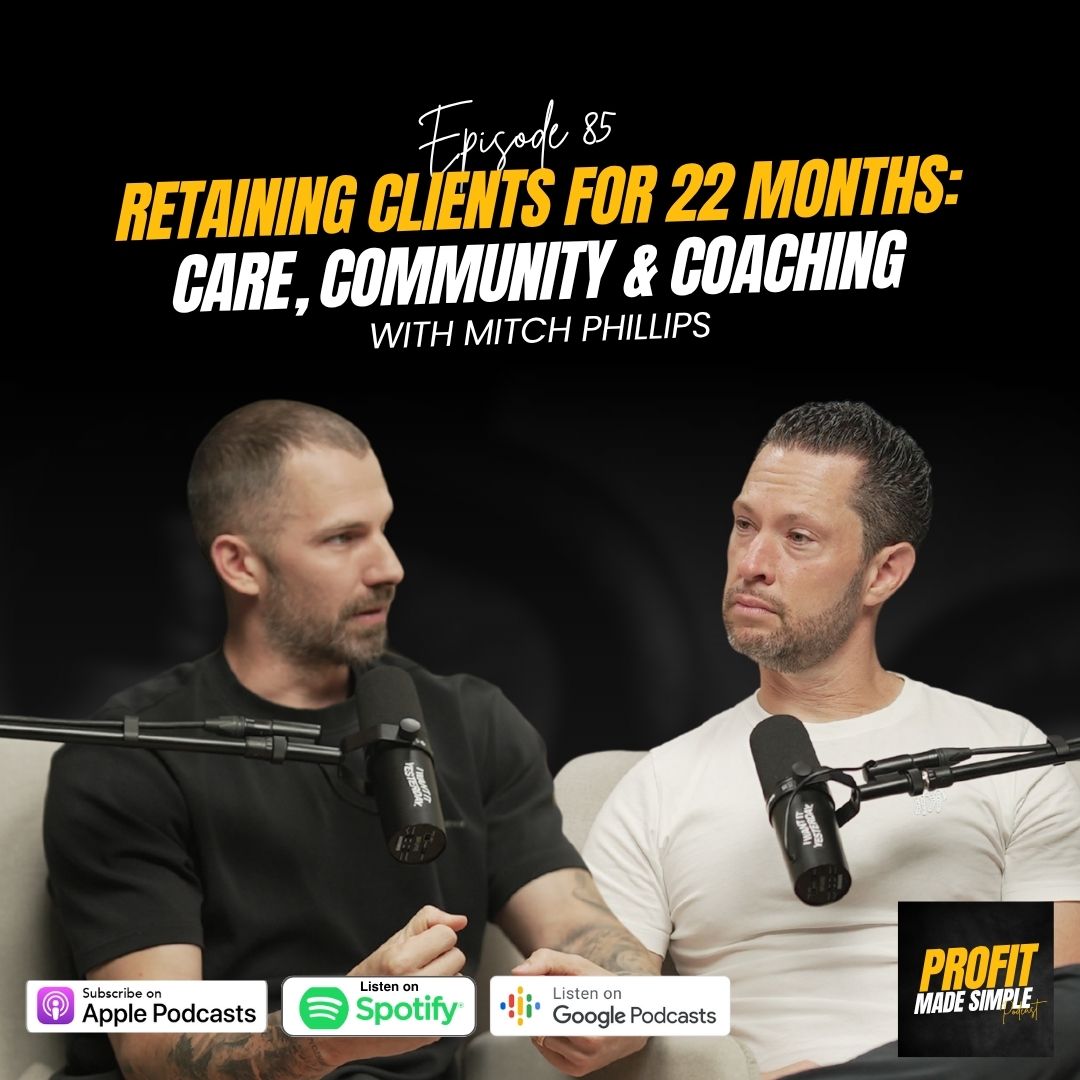Improving Gym Retention: How RFT Keeps Clients for 22 Months and Counting
In this week’s episode of Profit Made Simple, we welcomed back a crowd favourite — Mitch Phillips, owner of RFT. Mitch’s first episode became the most watched in the show’s history, so it made perfect sense to bring him back.
This conversation dives deep into one of the biggest challenges for any fitness business owner… improving gym retention. Mitch has achieved an incredible average client lifespan of 22 months, and in this episode, he breaks down exactly how.
Through a mix of care, community, and connection, RFT has created a retention machine that keeps clients engaged for the long haul. Here’s how they’ve done it and how you can apply the same principles in your own studio.
1. Care with Purpose
When Mitch talks about “care,” it’s not just about being friendly or creating a welcoming atmosphere. At RFT, care is professional responsibility.
As Mitch explains, “We care about the success of our clients. That means having the hard conversations, keeping them accountable, and coaching them through challenges.”
To make that practical, RFT uses what Mitch calls a 70/30 split:
- 70% Professional relationship – focused on coaching, accountability, and results.
- 30% Personal relationship – the camaraderie that builds over time.
This balance ensures that care isn’t just emotional; it’s structured, consistent, and drives outcomes.
It’s easy for fitness professionals to blur the line between coach and friend. But as Mitch puts it, “Clients already have enough friends. They come to us for transformation.”
When you prioritise accountability as the ultimate form of care, you help clients grow and that’s what keeps them around.
2. Building Community That Sticks
While care drives personal connection, community creates belonging.
At RFT, community isn’t left to chance. It’s engineered. Every client trains in a consistent small-group pod… the same people, same time, every week. Over time, that consistency builds trust, camaraderie, and a powerful sense of identity.
Mitch explains that RFT’s retention skyrocketed after COVID, when they doubled down on community-based training. They also introduced structured events and experiences to strengthen those bonds.
Each month, RFT runs events such as:
- Breathwork and recovery sessions
- Learn to Lift workshops
- Game Days with strength testing and friendly competition
- Team-based challenges that combine individual and group goals
This rhythm keeps clients engaged beyond their workouts. “The goal,” Mitch says, “is to create connection that goes beyond the coach. When members build three or more meaningful relationships in the gym, they stay for the long term.”
Community is no longer an afterthought — it’s a core retention strategy.
3. Personal Training, Delivered in a Small-Group Setting
RFT’s training model is simple: personal training, delivered in a small-group environment. Each session has up to ten clients with one coach, but every person still receives a personalised experience.
How? Through structure and adaptability.
Each quarter, RFT runs a 13-week program phase that sets the foundation. Coaches are trained to modify and personalise exercises for each client within that framework. So, if Mary can’t overhead press due to a shoulder issue, the coach adapts it immediately without losing flow.
But the real personalisation happens outside the gym. RFT calls this non-sweat coaching — the habits, nutrition, and lifestyle guidance that determine 80% of a client’s results.
Mitch sums it up perfectly:
“Training is just the stimulus. The transformation happens through accountability and coaching outside the session.”
This approach reframes small-group training. It’s not about the headcount, it’s about the experience and outcomes.
4. Onboarding That Predicts Retention
If you want to improve gym retention, start with onboarding. Mitch says it bluntly:
“If someone doesn’t get a result in the first six weeks, they’ll probably leave in the first six months.”
That’s why RFT invests heavily in the first month of every client’s journey.
Each new member begins with a 45–90-minute onboarding session. This session sets expectations, builds connection, and introduces RFT’s “Dial Plan” — a framework for tailoring health behaviours to individual lifestyles.
Every client works on the same five key habits, but the intensity is adjusted based on their capacity. Whether they’re a busy CEO or a new parent, the plan is achievable yet effective.
The onboarding phase also includes:
- Fixed training times for routine and accountability.
- Weekly coaching check-ins.
- Exposure to every service from strength to recovery.
- A Week 4 progress scan to celebrate tangible wins.
By Week 6, clients have already seen progress, built relationships, and developed structure — the three factors that make them stay.
5. Tracking What Matters
Data underpins every retention decision at RFT. Mitch and his team track:
- Visits per week – the most accurate predictor of longevity.
- App engagement – habits tracked, sessions logged, coach interactions.
- Responsiveness to accountability – if a client stops replying, the team reaches out immediately.
- In-studio energy – how engaged clients appear during sessions.
If someone’s engagement dips across two or more metrics, the coach calls them personally. Not an email. Not an automated message. A real phone call.
It’s this proactive, human approach that stops drop-offs before they happen.
6. Recognition and Loyalty Systems
Mitch believes in celebrating consistency, not just results.
RFT rewards loyalty through milestone gifts and recognition programs:
- At 6 months, members receive a branded hat.
- At 12 months, they earn the exclusive “Not Bought” shirt only given, never sold.
- At 10 years, members get a limited-edition shirt in a unique colour.
Each piece of RFT merchandise represents commitment and status. As Mitch says, “It’s not about the gift — it’s about what it symbolises.”
They also hand-write cards to new members and long-term clients, creating a personal touch that can’t be automated.
It’s these unscalable, thoughtful gestures that make clients feel genuinely valued and keep them proudly wearing RFT gear year after year.
Key Takeaways for Fitness Business Owners
If you’re a studio owner or gym operator looking to improve gym retention, Mitch’s playbook offers a clear roadmap:
- Lead with care, not comfort. Accountability is the highest form of love.
- Engineer community. Schedule events and fix pods for connection.
- Deliver personal coaching at scale. Focus on lifestyle and behaviour, not just training.
- Invest in onboarding. The first six weeks predict the next six months.
- Track attendance and engagement. Then act fast when metrics drop.
- Celebrate loyalty. Recognition builds identity and pride.
Improving gym retention isn’t about discounts, gimmicks, or overhauling your model. It’s about building a business where clients feel seen, supported, and successful.
Final Thoughts
What stands out about RFT’s approach is that none of it is accidental. Every touchpoint from onboarding to anniversaries is intentional and systemised.
Their results prove what’s possible when care, community, and coaching collide with structure and purpose.
As Mitch says, “You can’t force change, but you can create an environment that supports it.”
That environment is the reason RFT clients stay for almost two years on average and it’s the model that every fitness business owner can learn from.







Leave A Comment